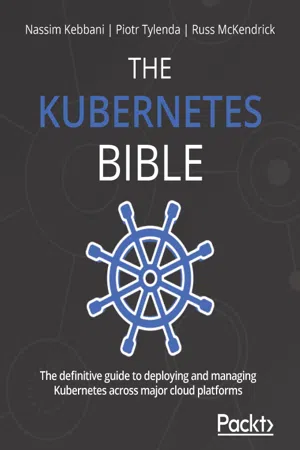
- 680 pages
- English
- ePUB (mobile friendly)
- Available on iOS & Android
The Kubernetes Bible
About this book
Get up and running with Kubernetes 1.19 and simplify the way you build, deploy, and maintain scalable distributed systemsKey Features• Design and deploy large clusters on various cloud platforms• Explore containerized application deployment, debugging, and recovery with the latest Kubernetes version 1.19• Become well-versed with advanced Kubernetes topics such as traffic routing or Pod autoscaling and schedulingBook DescriptionWith its broad adoption across various industries, Kubernetes is helping engineers with the orchestration and automation of container deployments on a large scale, making it the leading container orchestration system and the most popular choice for running containerized applications.This Kubernetes book starts with an introduction to Kubernetes and containerization, covering the setup of your local development environment and the roles of the most important Kubernetes components. Along with covering the core concepts necessary to make the most of your infrastructure, this book will also help you get acquainted with the fundamentals of Kubernetes. As you advance, you'll learn how to manage Kubernetes clusters on cloud platforms, such as Amazon Web Services (AWS), Microsoft Azure, and Google Cloud Platform (GCP), and develop and deploy real-world applications in Kubernetes using practical examples. Additionally, you'll get to grips with managing microservices along with best practices.By the end of this book, you'll be equipped with battle-tested knowledge of advanced Kubernetes topics, such as scheduling of Pods and managing incoming traffic to the cluster, and be ready to work with Kubernetes on cloud platforms.What you will learn• Manage containerized applications with Kubernetes• Understand Kubernetes architecture and the responsibilities of each component• Set up Kubernetes on Amazon Elastic Kubernetes Service, Google Kubernetes Engine, and Microsoft Azure Kubernetes Service• Deploy cloud applications such as Prometheus and Elasticsearch using Helm charts• Discover advanced techniques for Pod scheduling and auto-scaling the cluster• Understand possible approaches to traffic routing in KubernetesWho this book is forThis book is for software developers and DevOps engineers looking to understand how to work with Kubernetes for orchestrating containerized applications and services in the cloud. Prior experience with designing software running in operating system containers, as well as a general background in DevOps best practices, will be helpful. Basic knowledge of Kubernetes, Docker, and leading cloud service providers assist with grasping the concepts covered easily.
Frequently asked questions
- Essential is ideal for learners and professionals who enjoy exploring a wide range of subjects. Access the Essential Library with 800,000+ trusted titles and best-sellers across business, personal growth, and the humanities. Includes unlimited reading time and Standard Read Aloud voice.
- Complete: Perfect for advanced learners and researchers needing full, unrestricted access. Unlock 1.4M+ books across hundreds of subjects, including academic and specialized titles. The Complete Plan also includes advanced features like Premium Read Aloud and Research Assistant.
Please note we cannot support devices running on iOS 13 and Android 7 or earlier. Learn more about using the app.
Information
Table of contents
- THE KUBERNETES BIBLE
- Contributors
- Preface
- Section 1: Introducing Kubernetes
- Chapter 1: Kubernetes Fundamentals
- Chapter 2: Kubernetes Architecture – From Docker Images to Running Pods
- Chapter 3: Installing Your First Kubernetes Cluster
- Section 2: Diving into Kubernetes Core Concepts
- Chapter 4: Running Your Docker Containers
- Chapter 5: Using Multi-Container Pods and Design Patterns
- Chapter 6: Configuring Your Pods Using ConfigMaps and Secrets
- Chapter 7: Exposing Your Pods with Services
- Chapter 8: Managing Namespaces in Kubernetes
- Chapter 9: Persistent Storage in Kubernetes
- Section 3: Using Managed Pods with Controllers
- Chapter 10: Running Production-Grade Kubernetes Workloads
- Chapter 11: Deployment – Deploying Stateless Applications
- Chapter 12: StatefulSet – Deploying Stateful Applications
- Chapter 13: DaemonSet – Maintaining Pod Singletons on Nodes
- Section 4: Deploying Kubernetes on the Cloud
- Chapter 14: Kubernetes Clusters on Google Kubernetes Engine
- Chapter 15: Launching a Kubernetes Cluster on Amazon Web Services with Amazon Elastic Kubernetes Service
- Chapter 16: Kubernetes Clusters on Microsoft Azure with Azure Kubernetes Service
- Section 5: Advanced Kubernetes
- Chapter 17: Working with Helm Charts
- Chapter 18: Authentication and Authorization on Kubernetes
- Chapter 19: Advanced Techniques for Scheduling Pods
- Chapter 20: Autoscaling Kubernetes Pods and Nodes
- Chapter 21: Advanced Traffic Routing with Ingress
- Other Books You May Enjoy